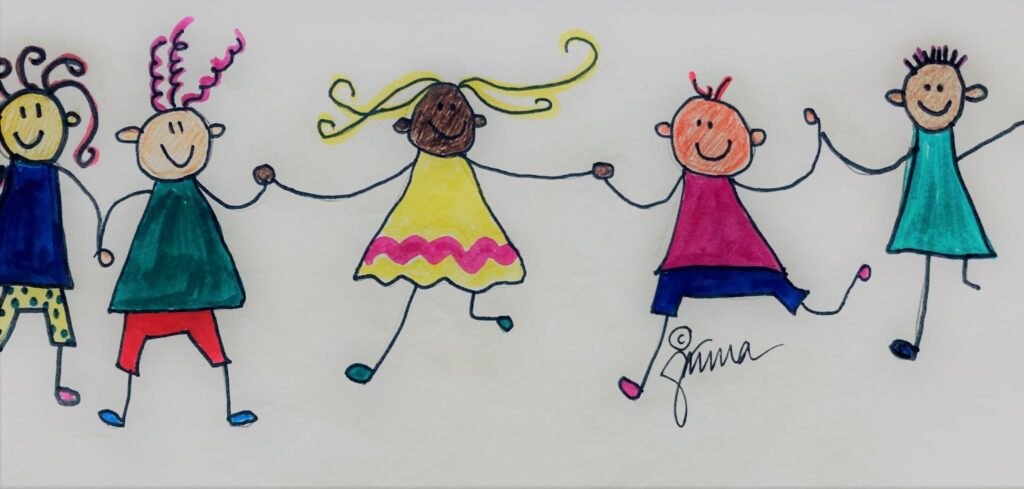From ELT Teacher to YL Teacher
With my CELTA in hand, I was ready for my first teaching job. My timetable included 9 – 12 year-olds. No sweat! I’d worked on play schemes for children and so I imagined teaching them would be the same. How wrong I was! All my new CELTA techniques just didn’t work and I was soon shouting for help.

Here are some of the things I wish I’d been told before I started:
1 Learn your students names and use them!
My learners make name cards on a folded piece of card on Day 1. Once I’ve got their names right (including the correct pronunciation), I reuse these cards for assigning seats or groups, picking students at random etc.
2 Be prepared
Plan and prepare the class beforehand. Young Learners won’t wait for you to find the answers in the teacher’s book, make extra copies of a worksheet or look for the audio track. During the time it takes to turn your back to write two or three answers on the board, Ana has probably stabbed David with her new pair of scissors.
3 Develop a lesson routine and stick to it
This is my standard lesson routine:
- Welcome the learners into the room and tell them where to sit. Coats off, bags under the chair and remove all distractors (= anything that the learners can fiddle with, grab, chew, bite, throw etc).
- Make a firm start! Call the register and use this moment to revise some language from a previous class. For example, with prepostions:
Teacher: Is Jon here?
Student: Yes, I’m over here!
Teacher: Where?
Student: I’m here, next to Martin.
- Introduce some new language. Remember that learners are often most alert at the beginning of a class so use this time for the new.
- Quiet time! After about 20 minutes of intense language practice, your learners may be losing concentration so send them back to their desks to do something on their own. This could be a short exercise, some labelling, tracing or drawing.
- Check the homework. I always use the last part of the class to go over homework when students are beginning to flag.
- Set some new homework. One reason why younger students do not do their homework is because they haven’t understood what they have to do. Do the first two or three questions together orally as a class. Either project the exercise onto the board or ask the students to look at their books with pens down.
- Leave on a high! Play a game for the last five minutes. Get some energy going and send them out to their carers making noise (in English, of course).
- Password and go! Ask them to tidy up the classroom. Then it’s time to line up at the door to say the password. For this, I encourage them to do some very simple self-reflection. For example, I ask each individual to say their favourite word of the day, describe the activity they liked best etc.
4 Establish the class rules from day one and stick to them.
Quite often, young learners do not understand how we expect them to behave and we need to keep remnding them. For example, in their own school lessons, it may be acceptable to stand up and walk around the classroom, go to the toilet without asking or speak over the teacher. Remember to list both the DOs and the DON’Ts, for example, ‘listen to me, but don’t speak!’ Also decide what you’re going to do if a child behaves inappropriately; whatever you do, point out this instance of misbehaviour. BUT don’t forget to acknowledge instances of very good behaviour – see below.
5 Smile and encourage. But praise where praise is due.
Smile lots and tell the learners they’re doing well. As for praise, you need to find the balance between praising what we expect them to do anyway and praising behaviour which is above and beyond what we would expect. For example, if a child lends a classmate their favourite pencil or goes out of their way to help another, then this deserves praise.
6 Get some further training!
My own favourite YL training course is IH World’s IHCYLT and there is now an online version. Follow the blogs of YL gurus like Carol Read. Chris Roland has a great book, ‘Structuring fun for Young Learners in the ELT Classroom’ with an accompanying smaller book for teaching online. Finally, IATEFL has its own SIG (Special Interest Group) for teachers of YLs.
But above all, I’ve learnt that teaching young learners is a lot of fun! What would you add to my tips? Please do leave a comment below or get in touch via contact.
4 thoughts on “From ELT Teacher to YL Teacher”
Very impressive and easy to follow
Thanks Abby!
Thanks for the article Emma. I agree with everything you say. The only remaining caveat I would add is to highlight the importance of classroom management. You do mention this but I would emphasize this as the most important pre-requisite of YL teaching and the younger they are, the greater its significance. From my experience, it doesn’t matter how good your lesson materials are, without effective classroom management, it’s doomed to fail. I found this out from personal experience. I came you YL teaching at a later stage in my career and I have to say it has given my teaching a boost and a fresh energy. I’d recommend giving it a go even, like myself, you have doubts.
Thanks again Emma.
Richard
Poland. 🙂
Thanks for your reply Richard,
I couldn’t agree more! Unfortunately, the word ‘management’ for some has a negative connotation and some teachers shy away from it. However, once this is in place, all the fun, creativity and curiosity (as a colleague put it) can begin!
Emma
Comments are closed.